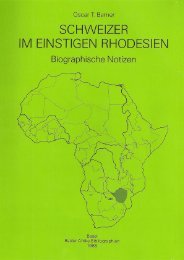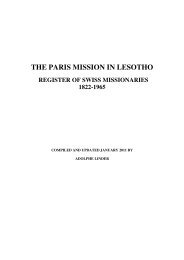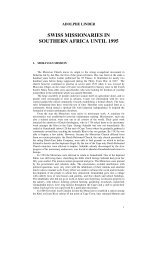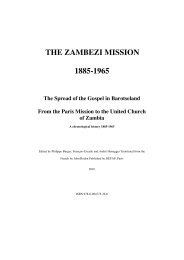THE SWISS IN SOUTHERN AFRICA 1652-1970 - swissroots-za.ch
THE SWISS IN SOUTHERN AFRICA 1652-1970 - swissroots-za.ch
THE SWISS IN SOUTHERN AFRICA 1652-1970 - swissroots-za.ch
You also want an ePaper? Increase the reach of your titles
YUMPU automatically turns print PDFs into web optimized ePapers that Google loves.
the Huguenot brothers Guillaume and Francois du Toit embarked on the Vrijheid for<br />
the Cape, where they hoped to find a better life. 2 Ea<strong>ch</strong> Huguenot settler was promised a<br />
farm of 60 morgen (51,4 hectares) plus a team of six oxen and a cart, a plough, seed and<br />
all that was further necessary for agriculture as a loan to be repaid within three or four<br />
years. 3<br />
Marga was allocated land near Stellenbos<strong>ch</strong> (next to what is now the wine farm<br />
Blaauwklippen) whi<strong>ch</strong> he named Valley Lustre. 4 Margra and the Du Toits found<br />
everything here to their satisfaction, sent a positive report back to Middleburgh and on<br />
26.5.1688 obtained permission to bring out their wives. 5 It is possible that their report<br />
had a decisive influence in persuading other Huguenot families to emigrate to the Cape.<br />
When in 1690 the Consistory of Batavia sent a sum of money to be distributed<br />
amongst the Huguenot settlers according to their needs, Margra was also given a share<br />
and on this basis is recorded as a Huguenot. 6 By 1692, after farming for four years, he<br />
had 12 head of cattle, 100 sheep, 3 000 vines and sowed/harvested 4/28 bags wheat, 2/8<br />
bags rye and ½ bags barley. 7 He also had considerable debts from whi<strong>ch</strong> he sought<br />
relief by making a partnership agreement with Barent Lubbe to farm jointly, for whi<strong>ch</strong><br />
Lubbe took over all his debts. 8 Barent Lubbe, the forefather of the Lubbes in South<br />
Africa, had a daughter, Eli<strong>za</strong>beth, born in 1702, who later married Jan Vorster of Berne,<br />
the forefather of the Vorsters in South Africa. 9<br />
Margra’s age was never recorded at the Cape. Was it old age or sickness that caused<br />
him to sell his farm in 1697 after he had more than doubled his vineyard to 7 000<br />
bearing vines? Jan Jansz Swart, the sick comforter at Stellenbos<strong>ch</strong> bought Margra’s<br />
farm for 1 600 gulden but failed to pay the pur<strong>ch</strong>ase price. Margra had to resort to court<br />
action resulting in the farm being acquired by his friend Guillaume du Toit. 10 With the<br />
marriage of Guillaume’s daughter to Jan Oberholster of Zuri<strong>ch</strong>, Valley Lustre later<br />
again passed into the hands of a Swiss.<br />
Having sold his farm, Margra bought a smallholding in Stellenbos<strong>ch</strong> called Het<br />
Eiland. This is possibly the island on whi<strong>ch</strong> Governor Simon van der Stel spent a night<br />
and where he decided to found Stellenbos<strong>ch</strong> in 1680. Some adjoining land is thought to<br />
have included what is now the Braak at the centre of Stellenbos<strong>ch</strong>. 11 Only two years<br />
later Margra died leaving no descendants.<br />
/ Bou<strong>ch</strong>er: Fren<strong>ch</strong> Speakers; 2 Coetzee: Line of Descent; 3 Valenttyn: Bes<strong>ch</strong>ryvinge<br />
van de Kaap, p. 187; 4 KAB, DO, SFI 93, 8.6.1694; 5 KAB, C 1381, p. 81; 6 KAB, C<br />
728, 8.11.1698; 7 KAB, J 183: Citizens Roll 1692; 8 KAB, 1/STB/18/40, 18.11.1692; 9<br />
De Villiers: Genealogies; 10 KAB, DO, T412, 6.3.1697 and CJ 3:11, and CJ 3:44, and<br />
DO, T511, 11.4.1698; 11 KAB, DO, T452, 3.12.1698 for portion of Callebasse Kraal,<br />
8565 sq.m. and T451, 2.12.1698 of adjoining land Eylandje. By T463 the latter was<br />
transferred from the estate of the late Margra to Jan Frederik Fols.<br />
Krebs, Jakob born Berne may have arrived at the Cape in 1685, and after serving his<br />
five year contract, settled here as a free shoemaker. 1<br />
A SHOEMAKER’S TRADE DESCRIBED<br />
A shoemaker not only repaired broken shoes but also made new shoes, fashioning<br />
them from a single piece of leather whi<strong>ch</strong> he had tanned himself from raw skins. First<br />
the newly flayed skins were prepared for tanning by cleaning them roughly and salting<br />
them for preservation. They were then left in running water for about 30 hours to<br />
dehydrate, then dried and suspended in a lime solution and again dried, after whi<strong>ch</strong> the<br />
skin would again be carefully scraped clean. Finally the tanning process itself took place<br />
by passing the properly prepared skins for varying periods through solutions of<br />
increasing tanning strength. It would take 12 to 18 months to produce leather of good<br />
quality.<br />
The bark of selected bushes and trees was used as a tanning agent. The shoemakers<br />
collected these in the surrounding areas to su<strong>ch</strong> an extent that in 1709 the Governor<br />
found it necessary to issue a Plakaat (Proclamation) stating that the shoemakers, being<br />
in the habit of denuding the underwood and other useful kinds of timber of their bark<br />
for tanning purposes, were henceforth prohibited to do so without written authority. 2<br />
40







